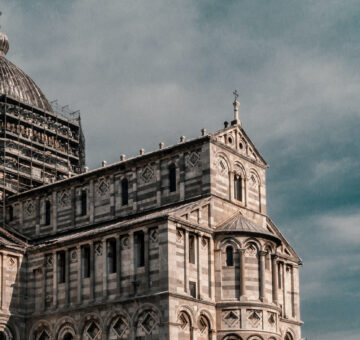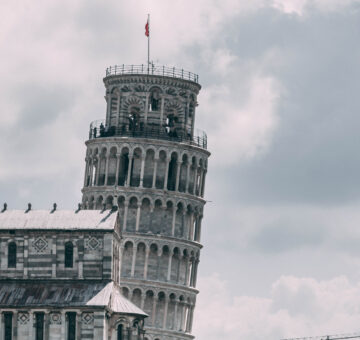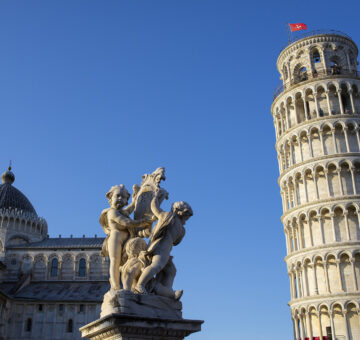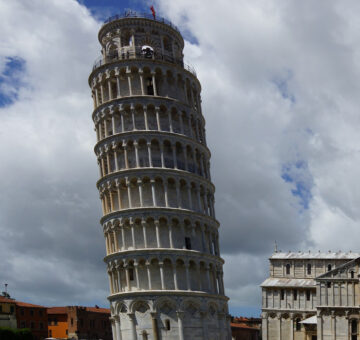Leaning Tower of Pisa
 The Leaning Tower of Pisa, situated in the Piazza dei Miracoli, is mainly known for its almost 4 degrees inclination. Built during the medieval period, it serves as the bell tower to the nearby cathedral. Seen as a staple of the Italian culture, the monument welcomes over 5 million visitors every year.
The Leaning Tower of Pisa, situated in the Piazza dei Miracoli, is mainly known for its almost 4 degrees inclination. Built during the medieval period, it serves as the bell tower to the nearby cathedral. Seen as a staple of the Italian culture, the monument welcomes over 5 million visitors every year.
Known for its inclination, the Tower of Pisa is maybe the most famous tourist photo spot in the world. Situated in Pisa, Tuscany, the construction is part of an important center of the medieval period, both artistically and architecturally, the Piazza del Miracoli or Piazza del Duomo. The Catholic Church considers the Piazza sacred. In fact, it includes four important religious edifices such as the Pisa Cathedral, the Pisa Baptistery, the Campanile and the Camposanto Monumentale (Monumental Cemetery).
Built to show the city's prosperity and strength, the now leaning structure was the bell tower of the nearby Pisa Cathedral. Bonanno Pisano, a well-known Italian architect of the 12th century, was believed to be the Tower of Pisa’s designer since the discovery of a piece of cast holding its name in 1820, buried near the tower’s base. However, a recent study indicated that the architect Diotisalvi was the original designer, as the architectural style greatly resembles his.
Its construction that lasted over 199 years began in 1173 with the laying of the foundations and the work on the ground floor. A few years later, the tower started to sink while the second floor was under development. Caused by insufficient three meters deep foundations set in weak and unstable soil, it forced the stoppage of the work for merely a century. The construction resumed in 1272 under a new architect, Giovanni di Simone but was halted again after the battle of Meloria. Di Simone and his workers, however, tried to compensate the inclination, by making the leaning side of the upper floors taller than the others. The last floor and the bell chamber were added during the 14th century, finally completing the construction. During the following centuries, seven bells were installed, each one representing a note on the major scale. Also, the 5th bell is actually older than the bell-chamber itself, since it was retrieved from another bell tower, Vergata.
Many efforts were made to restore the tower’s verticality or at least stabilize the foundations, to prevent it from tilting further and eventually crashing. However, most of them failed or even made things worst. As a result, the monument was closed to the public in 1990 after the collapse of the Civic Tower of Pavia, the year earlier. Finally, the public was welcomed again in 2001 after 38 cubic meters of the soil (1342 cubic feet) were strategically removed, reducing the tilt by 45 centimeters (17.7 inches). In May 2008, the engineers in charge of fixing the tilting announced that the tower had stopped moving for the first time in history and that the tower should remain this way for at least 200 years.
In terms of numbers, the Tower of Pisa is 55.9 meters tall (183 ft.) and has a diameter of 15.5 meters (50.9 ft.). Mainly made out of white marble, its total weight is estimated at 14 700 metric tons (32 407 955 lbs.) and its current tilt angle at 3.97 degrees. Every visitor willing to reach the top must climb an impressive 296 steps. UNESCO declared the Piazza del Duomo, in which the tower resides, a World Heritage Site in 1987.
Considered a must-see for all tourists visiting Italy, the Leaning Tower of Pisa is a staple of the medieval period and its architecture. For the better or the worst, with over 5 million visitors every year, we can surely expect the birth of many new silly pictures!





